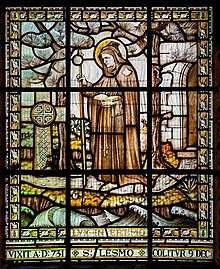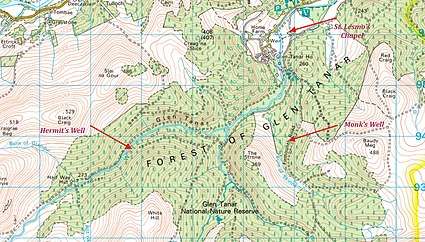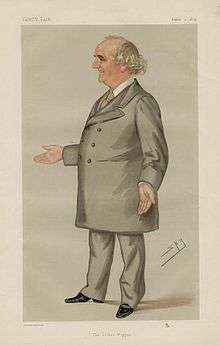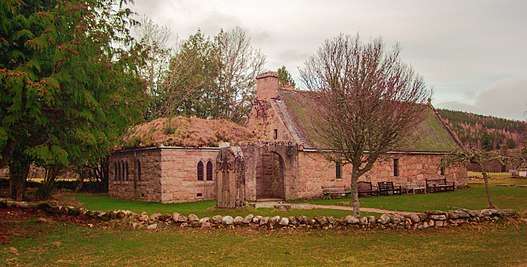St. Lesmo of Glen Tanar
St. Lesmo of Glen Tanar (c. 700 – c. 780) is the name given to a holy hermit who it is believed lived in Glen Tanar Aberdeenshire Scotland in the eighth century. He is recorded by Thomas Dempster as a "saint" in the seventeenth century. [1] His claimed Saints’ Day is the 9 December.[2]


There is no reference to a Lesmo in the Aberdeen Breviary (1507). [3] This omission raises doubts regarding Lesmo and claims for his Sainthood. [4] Sixteen saints are recorded as being active during a period from c. 500 AD to c.800 AD along the River Dee, Aberdeenshire. [5] The Aberdeen Breviary lists 81 saints, including twelve associated with Deeside. [6] Nevertheless, he is recorded by many Scottish writers in the late nineteenth and early twentieth century. [7]In 1871, a private Scottish Episcopal Church chapel was dedicated to Lesmo by Bishop Thomas Suther, Bishop of Diocese of Aberdeen and Orkney. The chapel was part of a grand building scheme by William Cunliffe Brooks on his new estate. The chapel has a fine stained-glass window commemorating Lesmo. [8] Lesmo stands in front of what looks like the South side of the church. Below is the aphorism, "LUX IN EREMO"; translated as "Light in the Wilderness". It has been suggested that "LUX IN EREMO", might be code for "LUX IN ER(S)MO". A second text along the bottom of the window reads “VIXIT AD 731 COLITUR 9 DEC” “He lived in AD731 – Commemorate him on the 9th. December”. Almost certainly the face of St Lesmo in this panel is based on a photograph or cartoon of Cunliffe Brooks. [9] The designer of the window gave Lesmo a staff with a scallop shell on his left shoulder suggesting a pilgrim saint. The scallop shell referring to Saint James who is the patron saint of pilgrims and of the Camino de Santiago. It is unknown where the stained-glass was originally located as its current position, in the north wall, was the location of the original entrance into the chapel. Looking at the Lesmo window from the outside, the lintel contains an inscription “VENITE ADOREMUS” - “Come Ye, Let us Adore”. [10]

Lesmo as a Saint
It is claimed that he "ministered" to travellers on the Firmounth path.[12] If there had been a "holy hermit" in the eighth century, it is likely that places would have been named after him. There are no examples of the name "Lesmo" in Aberdeenshire. [13] There are some claims for a Hermit’s Cave or Hermit’s Well in Glen Tanar. A Hermit’s Well was recorded near Porphyry Bridge on a 1955 UK Ordnance Survey map. This location, near the Water of Tanar, is about 4 kms. to the SW of St Lesmo’s Chapel and Glen Tanar House. This site is not marked on the latest Ordnance Survey map.

The exact location of this well is unknown. There is a Monk's Well marked on some maps adjacent to the Firmounth Road. It is probable that Monk's Well might have been applied to this spring by William Cunliffe Brooks.
The Name Lesmo
Scots Gaelic gives no clues to the possible derivation of the name "Lesmo". [14] Reversing some of the letters of the name might provide a possibility. For example, there is evidence for an E l m o known as ELMO or Erasmus in Fife. The place-name Lesmahagow refers to a community near Lanark. No connection between Lesmahagow, Erasmus, Elmo or Lesmo is found in this part of Scotland. [15]
St. Lesmo's Chapel in Glen Tanar
In the early 1600s a family named Garden, acquired property in Glen Tanar. In c.1639 they took up residence in what was called the House of Braeloine. In 1869 Sir William Cunliffe Brooks became tenant of the Glen Tanar estate. [16]Braeloine House was in ruins and Cunliffe Brooks undertook an extensive building programme. He built a chapel from the ruined walls of the old Braeloine House, incorporating into it, as the entrance, a yett or arched iron gateway. [17]

The chapel was built with a thatched roof and stained-glass windows. The spaces between the stones of the walls are dotted with small pebbles. A technique called locally cherry-cocking. In the chapel, the rafters were whole trees minus the bark; and the joists were twisted branches of locally grown Scotch Fir (Pinus sylvestris). The pulpit and seats were in the same style, coated with stainless varnish. The ceiling was emblazoned with gilded stars with convex centres of silvered glass. The altar piece was covered with rich purple and surmounted by an oil painting of the Virgin and Child. The altar steps were of local granite. At a later stage, deer skulls with antlers were hung from the roof with the year they had been shot and the initials of the marksman imprinted on them. An organ was placed at the west end of the Chapel. Outside a bell was hung which was cast to order and bears the inscription "St Lesmo". The Chapel was consecrated on 15 November 1871.


The Bishop, at the consecration said, "….. we dedicate and consecrate it as a chapel to the sacred name of God, to His service and worship … and in pious memory of the holy hermit St. Lesmo …." In 1871 the Marquess of Huntly owned the ground on which the chapel was built. However, in 1872 this ground was feued to the Bishop of Aberdeen and Orkney and his successors as Trustees of the Scottish Episcopal Church solely for use as an interdenominational private chapel. The chapel is used for private weddings.
The figure to the right marks the location of the "St. Lesmo" stained-glass window. [*]
The Status of St. Lesmo
The lack of evidence for a saint called Lesmo does not mean that there is no oral history. Lesmo is recorded in many authors in guide books and descriptions of the Glen Tanar Estate. [18] The status of sainthood is generally a matter for the Western Christian Church. The Catholic Church does not officially recognise him. He has not been awarded a Saint’s Day. The Church of Scotland and other Reformed Churches do not recognise the beatification or canonisation of individuals. The Scottish Episcopal Church allows a dedication to an individual, for example to a Church, if there is community support. It is probable that during the eight century, many anchorite hermits would have been found along the River Dee, Aberdeenshire. A likely location to the west of the Cairn O’Mount path would be the Firmounth path. [19]A hermit or acolyte of one of the early Christian evangelists, e.g. St Ternan (Banchory) , or St Erchard (Kincardine O’Neil) may have lived on or near the Firmounth path. A "Lesmo" could have been such a hermit. St. Lesmo lives on the dedication made by William Cunliffe Brooks with the name of his chapel and in the stained-glass window.
References
- Dempster was a Scottish Scholar and Antiquarian . He was born at Cliftbog, Aberdeenshire. Dempster’s authority has been open to serious doubt for some time. As early as 1736, William Nicholson, said of Dempster "… (he) was as well inclined to believe a lye(lie) as any man of his time…"; see, ‘Nicolson, William. 1736. The English, Scotch and Irish historical libraries. ….a general history of England (Printed for G. Strahan etc.: London,), p58. Nicholson, also criticizes Dempster’s list of "…274 saints, two popes, nine cardinals 38 kings and princes 41 apostolic missionaries…". Further recent criticism of Dempster’s authority can be found by Douglas Somerset in, "The Reforming of the Aberdeen Friaries on 4th January 1559/6"; Scottish Reformation Society Historical Journal, vol. 4 (2014), 63-95; p67.
- See, Dempster, Thomas. 1625. Historia ecclesiastica gentis Scotorum lib. XIX (Typis Nicolai Thebaldini: Bononiae); and, Dempster, Thomas, David Irving, and Bannatyne Club (Edinburgh Scotland). 1829…. Dempster’s reference is confusing. He refers to " …. S. Lesmo, abbas in montibus Argadiae, non longe monasterio S. Filani...(.. St. Lesmo, an abbot in the mountains of the Argadie, not far from the monastery of Saint Filan..)" (See, Dempster, 1625 op. cit. V1, p.430 Ref. S. Lesmo 793. The reference to St Filan and to Argadie are qualified with a reference to "Glentanire". The 9th December as a Saints’ Day is also recorded in Boone, Jean-Baptiste. 1838. De prosecutione operis Bollandiani quod Acta sanctorum inscribitur (F.-J. Douxfils: Namurci), p.41.
- Only five copies of the Aberdeen Breviary exist. One was private hands (The Earl of Strathmore – until recently); two are in the National Library of Scotland [ Sa.3; F.6/f.5]; one in the University of Edinburgh Library [De.1/1.53-4] and one in the University of Aberdeen Library [pi³ 2642 Bre 4125 1] The Aberdeen copy is a composite copy that came to the University in 1785 from Robert Young a minister at Benholm. See, Beavan, Iain, Peter Davidson, Jane Stevenson, and University of Aberdeen. Library. 2011. The Library and archive collections of the University of Aberdeen : an introduction and description (Manchester University Press with the University of Aberdeen: Manchester), pp. 124-125. See also, Macquarrie, Alan (Ed.) Butter, Rachel, Simon Taylor, and Gilbert Márkus. 2012. Legends of Scottish saints : readings, hymns and prayers for the commemorations of Scottish saints in the Aberdeen Breviary (Four Courts Press: Dublin).
- A Breviary is a compendium of all the necessary liturgical texts for Divine Office. In the early sixteenth century, Bishop Elphinstone of Aberdeen at the request of James IV of Scotland, set out to provide a new Scottish Breviary. A project that was designed to exhibit the uniqueness of the Dioceses in Scotland. The existing Breviary was known as the Sarum Breviary. Elphinstone was assisted in this endeavour by a group of his closest Canons and advisors. Members of this group included Hector Boece (Principal. Of King’s College, Old Aberdeen) and Canon Alexander Galloway the Royal Notary and Diocesan Clerk for Diocese of Aberdeen. They searched across Scotland for evidence for Scottish Saints. The Breviary was the first published book by the Edinburgh publisher Chepman & Myllar in 1507. The book was known as the Breviarium Aberdonense. The Project was not entirely successful as few copies of the Breviary were sold before the Scottish Reformation of 1559/1560. See, Beavan, Iain, Peter Davidson, Jane Stevenson, and University of Aberdeen. Library. 2011. The Library and archive collections of the University of Aberdeen : an introduction and description (Manchester University Press with the University of Aberdeen: Manchester), pp. 124-125. See also, Macquarrie, Alan (Ed.) Butter, Rachel, Simon Taylor, and Gilbert Márkus. 2012. Legends of Scottish saints : readings, hymns and prayers for the commemorations of Scottish saints in the Aberdeen Breviary (Four Courts Press: Dublin).
- ?? Lesmo??, Adomnán/Skeulan/Eunan, Colm Cille, Devenick, Fumoc, I/Erchard, Kenneth, Kentigern/ Mungo, Machar, Manir, Marnock, Moluag, Ninian, Ternan, Voloc/ Macvoloc/ Walloch.
- Adomnán/Skeulan/Eunan p. 318, Colm Cille p. 339, Devenick p. 350, I/Erchard p. 367, Kenneth p.369, Kentigern/ Mungo p.370, Machar p. 379, Manir p. 386, Marnock p. 390, Moluag p. 395, Ninian p. 402, Ternan p. 418.
- See Additional Reading – below.
- The exact date is unknown. It may have been made by Clayton and Bell.
- It is a common practice for a donor to incorporate something of their person in a stained-glass window. Cunliffe Brooks also used a strong pictorial representation in a stained-glass insertion in his house. In this a conductor -modelled on him – is seen with four musicians.
- This phrase is part of the well-known traditional carol, O Come All Ye Faithful – “Adeste Fideles”.
- The Latin reads as "....S. Lesmo, abbas in montibus Argadiae, non longe monasterio S. Filani, postea in Glentanire eremita, cujus praeclaram conversationem servant loca in Scotia; in provincia Stryla Killesmont, quasi Lesmonis cella Thomae Dempsteri ac majorum, cum arce, patrimonium; in Argadia Kilmon, corrupte pro Killesmon, prope Touuart; in Glascoensi agro Lesmohago, licet haereticus historicus somnium fingat, ut sit e Gallico “L’église de Mathul” sive ecclesia Mathuli, nulla vocum vicinia. Acta omnia, quantum sciam, interierunt. Vixit confessor anno DCCXXXI. Colitur ix. Decembris....". A good translation of this Latin is almost impossible. Skilful translation reads as "....St. Lesmo, Abbot in the mountains of Argadia not far from the monastery of St Filanus [St Fillan], afterwards a Hermit in Glen Tanar, whose outstanding way of life they preserve [i.e. commemorate] in Scotland, in the province of Stryla Killesmont, as if the cell of Lesmo, of Thomas Dempster, and the older people [or ancestors], with a ?high point/citadel, a patrimony, corrupted in Argadia (to) Kilmon, for Killesmon, near Tanar, in the territory of Glasgow, (called) Lesmohago, it is permitted for the heretic historian to create a dream, as is in French ‘L’Eglise de Mathul, or the Church of Mathul, with no nearness of sounds, all his Acts [i.e. deeds, achievements], as much as I know, have perished. He lived, a Confessor, in the year 733.1. He is celebrated on December 9th....". Some of the self-references to Dempster ( as writer) are confusing.
- The Firmounth is one of several ancient roads or paths that allowed travellers from the south of Scotland to access Deeside. For details of the various paths see, Haldane, A. R. B. 2008. The drove roads of Scotland (Birlinn: Edinburgh)
- There are two occurrences of a place name containing "Les" in Aberdeenshire: Mains of Lesmoir - Lat 57,20.6, Long 2,52.3; Milton of Lesmore - Lat 57,20.6, Long 2,53.3. In 1900 a forester in Glen Tanar build a substantial house in Aboyne and named it "St Lesmo's Tower". This house served as a rectory for the Scottish Episcopal Church, St Thomas, in Aboyne for some time. See, https://online.aberdeenshire.gov.uk/smrpub/master/detail.aspx?Authority=ASH&refno=NO59NW0092
- The authoritative source of Celtic place-names in Scottish Gaelic is; "Watson, William J. 2002. The History of the Celtic place-names of Scotland (Birlinn: Edinburgh)". "Lesmo" has no explanation.
- Scottish Gaelic: Lios MoChuda)
- Cunliffe-Brooks insisted in calling the glen Tana. He claimed the origins of the place-name came from the Scots Gaelic "tana" - narrow. Giving the English "narrow glen". See McConnochie, Alexander Inkson. 1895. Deeside (Smith: Aberdeen), p . 86
- See, Dictionary of Scottish Architects http://www.scottisharchitects.org.uk/building_full.php?id=210023
- https://www.glentanar.co.uk/
- Many heritage paths cross the Mounth in the NE of Scotland. See http://www.heritagepaths.co.uk/pathdetails.php?path=126
Additional Reading
1. "The Chapel of Lesmo: Glen Tanar." n.d. Episcopal Church in Scotland. Aberdeen: Episcopal Church in Scotland.
2. Boardman, Steve and Williamson, Eila (Eds). 2010. The Cult of Saints and the Virgin Mary in Medieval Scotland (Boydell Press: Woodbridge).
3. Butler, Hubert. 1972. Ten thousand saints : a study in Irish & European origins (Wellbrook Press: Kilkenny, Ireland).
4. Cooper, Patrick, and Aberdeen Ecclesiological Society. 1893. Calendar of Scottish saints (Aberdeen Ecclesiological Soc.: Aberdeen).
5. Fouin, Francois Louis Pierre, and Steve Robertson. 2005. The early life and times of a Glen Tanar exile : memoirs of an Anglo-French Scot (Librario Publishing Ltd.: Kinloss).
6. Fouin, Francois Louis Pierre. 2009. Glen Tanar : valley of echoes and hidden treasures (Leopard Press: Inverurie).
7. Historic Scotland, GLEN TANAR ESTATE, ST LESMO'S CHAPEL, INCLUDING BOUNDARY WALL LB44, http://portal.historicenvironment.scot/designation/LB44; (accessed 10/3/19).
8. St Lesmo’s Episcopal Chapel, http://www.scottishchurches.org.uk/sites/site/id/3874/name/St+Lesmo%27s+Episcopal+Chapel+Aboyne+and+Glen Tanar+Grampian (accessed 10/3/19).
9. McConnochie, Alexander Inkson. 1895. Deeside (Smith: Aberdeen), pp 86-91.
10. Turpie, Tom. 2016. "North-East Saints in the Aberdeen Breviary and the Histori Gentis Scotorum of Hector Boece; Liturgy, History and religious Practice in Late Medieval Scotland". In, Jane Geddes (ed.), Medieval Art, Architecture and Archaeology in the Dioceses of Aberdeen and Moray (Routledge & British Archaeological Association: London).
11. Wyness, Fenton 1968. Royal Valley : the story of the Aberdeenshire Dee (Alex P. Reid: G.B.).
12. Wyness, Fenton, and Deeside Field Club. 1950. Royal Deeside (Mearns: Aberdeen).
13. Wyness, Fenton. 1942. Book of legends : tales of the north-east of Scotland told to children (W. & W. Lindsay: Aberdeen).